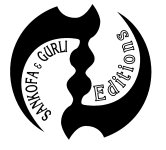Sankofa & Gurli is a Burkinabe publishing house created in 1995. With its creation, several objectives were fixed to promote literature while acting in various and complementary plans which include writing (support of and follow-up with authors), reading (communication with the public), and output and diffusion; to promote and revalorize the African languages, especially those spoken in Burkina Faso and transnational languages, across an editorial policy which avoids marginalizing publication in African languages (aesthetic of the form and the contents, topics, circulation of the publications...); to produce literature of quality at costs corresponding to the local purchasing power; to work to arouse in the children and the young people the taste for reading and writing, and anchor in them, as soon as possible, practices of output and consumption of the writing; in a general way, to contribute to the promotion, the development, and the reinforcement of culture, especially literary, in a context of generalized illiteracy. Since 1999, the contacts have been diversified, the commitments reinforced and widened: Sankofa & Gurli Editions participate with various partners (African, European, North American) in co-publishing projects;
Member of the Alliance of independent publishers, Sankofa & Gurli contributes to the debate and to the fight for bibliodiversity and solidarity in publishers’ independence across the world.
Le nom de la maison d’édition est double. SANKOFA est le nom de l’oiseau qui, dans la cosmogonie des peuples AKAN, symbolise la conscience historique. Son slogan est « Il n’y a pas de honte à revenir sur ses pas pour prendre ce qu’on a perdu/oublié en cours de chemin ». GURLI est le nom du hérisson en gulmancema. Il symbolise aux yeux du fondateur de la maison d’édition l’ingénuité enfantine et le caractère absolu de la liberté des idées. On racontait souvent aux enfants qu’il était impossible de garder prisonnier un hérisson. Toutes les tentatives par ces enfants d’en enfermer un se révélaient vaines, le hérisson disparaissait toujours de sa prison. Bien des années plus tard, l’enfant que j’étais (suis ?) a appris que c’étaient nos aînés qui libéraient le petit animal. Ainsi en est-il des idées : on a beau les enfermer, les emprisonner, il se trouvera toujours un moyen, une personne, une circonstance, qui les libérera...

















 Contact : Jean-Claude NABA
Contact : Jean-Claude NABA